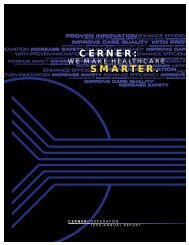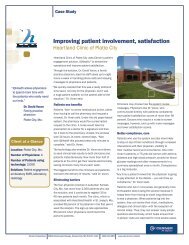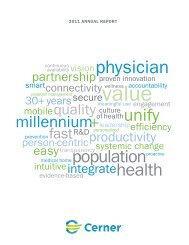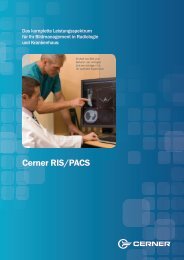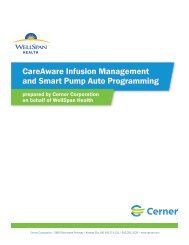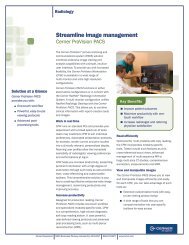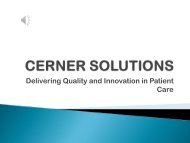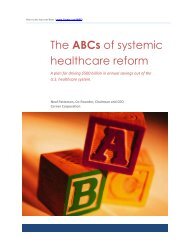The ABCs of systemic healthcare reform - Cerner Corporation
The ABCs of systemic healthcare reform - Cerner Corporation
The ABCs of systemic healthcare reform - Cerner Corporation
- No tags were found...
You also want an ePaper? Increase the reach of your titles
YUMPU automatically turns print PDFs into web optimized ePapers that Google loves.
Deferred revenue is comprised <strong>of</strong> deferrals for license fees, support, maintenance and other services for which payment has<br />
been received and for which the service has not yet been performed and revenue has not been recognized. Long-term deferred<br />
revenue at January 3, 2009, represents amounts received from s<strong>of</strong>tware support and maintenance services to be earned or<br />
provided beginning in periods on or after January 4, 2009.<br />
<strong>The</strong> Company incurs out-<strong>of</strong>-pocket expenses in connection with its client service activities, primarily travel, which are reimbursed<br />
by its clients. <strong>The</strong> amounts <strong>of</strong> ”out-<strong>of</strong>-pocket” expenses and equal amounts <strong>of</strong> related reimbursements were $37,759,000,<br />
$36,778,000 and $39,051,000 for the years ended January 3, 2009, December 29, 2007 and December 30, 2006,<br />
respectively.<br />
<strong>The</strong> Company’s arrangements with clients typically include an initial payment due upon contract signing and date-based<br />
licensed s<strong>of</strong>tware payment terms and payments based upon delivery for services, hardware and sublicensed s<strong>of</strong>tware. <strong>The</strong><br />
Company has periodically provided long-term financing options to creditworthy clients through third party financing institutions<br />
and has directly provided extended payment terms to clients from contract date. <strong>The</strong>se extended payment term arrangements<br />
typically provide for date based payments over periods ranging from 12 months up to seven years. Pursuant to SOP 97-2,<br />
because a significant portion <strong>of</strong> the fee is due beyond one year, the Company has analyzed its history with these types <strong>of</strong><br />
arrangements and has concluded that it has a standard business practice <strong>of</strong> using extended payment term arrangements and a<br />
long history <strong>of</strong> successfully collecting under the original payment terms for arrangements with similar clients, product <strong>of</strong>ferings,<br />
and economics without granting concessions. Accordingly, the Company considers the fee to be fixed and determinable in<br />
these extended payment term arrangements and, thus, the timing <strong>of</strong> revenue is not impacted by the existence <strong>of</strong> extended<br />
payments. Some <strong>of</strong> these payment streams have been assigned on a non-recourse basis to third party financing institutions.<br />
<strong>The</strong> Company accounts for the assignment <strong>of</strong> these receivables as “true sales” as defined in FASB Statement No. 140,<br />
“Accounting for Transfers and Servicing <strong>of</strong> Financial Assets and Extinguishments <strong>of</strong> Liabilities.” Provided all revenue<br />
recognition criteria have been met, the Company recognizes revenue for these arrangements under its normal revenue<br />
recognition criteria, and if appropriate, net <strong>of</strong> any payment discounts from financing transactions.<br />
<strong>The</strong> terms <strong>of</strong> the Company’s s<strong>of</strong>tware license agreements with its clients generally provide for a limited indemnification <strong>of</strong> such<br />
intellectual property against losses, expenses and liabilities arising from third party claims based on alleged infringement by the<br />
Company’s solutions <strong>of</strong> an intellectual property right <strong>of</strong> such third party. <strong>The</strong> terms <strong>of</strong> such indemnification <strong>of</strong>ten limit the scope<br />
<strong>of</strong> and remedies for such indemnification obligations and generally include a right to replace or modify an infringing solution. To<br />
date, the Company has not had to reimburse any <strong>of</strong> its clients for any losses related to these indemnification provisions<br />
pertaining to third party intellectual property infringement claims. For several reasons, including the lack <strong>of</strong> prior indemnification<br />
claims and the lack <strong>of</strong> a monetary liability limit for certain infringement cases under the terms <strong>of</strong> the corresponding agreements<br />
with its clients, the Company cannot determine the maximum amount <strong>of</strong> potential future payments, if any, related to such<br />
indemnification provisions.<br />
(d) Fiscal Year<br />
<strong>The</strong> Company’s fiscal year ends on the Saturday closest to December 31. Fiscal year 2008 consisted <strong>of</strong> 53 weeks and fiscal<br />
years 2007 and 2006 consisted <strong>of</strong> 52 weeks each. All references to years in these notes to consolidated financial statements<br />
represent fiscal years unless otherwise noted.<br />
(e) S<strong>of</strong>tware Development Costs<br />
Costs incurred internally in creating computer s<strong>of</strong>tware products are expensed until technological feasibility has been<br />
established upon completion <strong>of</strong> a detailed program design. <strong>The</strong>reafter, all s<strong>of</strong>tware development costs are capitalized and<br />
subsequently reported at the lower <strong>of</strong> amortized cost or net realizable value. Capitalized costs are amortized based on current<br />
and expected future revenue for each s<strong>of</strong>tware solution with minimum annual amortization equal to the straight-line<br />
amortization over the estimated economic life <strong>of</strong> the solution. <strong>The</strong> Company is amortizing capitalized costs over five years.<br />
During 2008, 2007 and 2006, the Company capitalized $69,981,000, $65,985,000 and $60,943,000, respectively, <strong>of</strong> total<br />
s<strong>of</strong>tware development costs <strong>of</strong> $291,368,000, $283,086,000 and $262,163,000, respectively. Amortization expense <strong>of</strong><br />
capitalized s<strong>of</strong>tware development costs in 2008, 2007 and 2006 was $51,132,000, $53,475,000 and $45,750,000,<br />
respectively, and accumulated amortization was $410,407,000, $356,485,000 and $303,010,000, respectively. Included in<br />
2007 total s<strong>of</strong>tware development costs is $8.6 million <strong>of</strong> research and development activities for the RxStation medical<br />
dispensing devices. $3.4 million <strong>of</strong> this amount recorded in 2007 is related to periods prior to 2007 and is immaterial to both<br />
2007 and the prior periods to which it relates.<br />
(f) Cash Equivalents<br />
Cash equivalents consist <strong>of</strong> short-term marketable securities with original maturities less than 90 days.<br />
65



